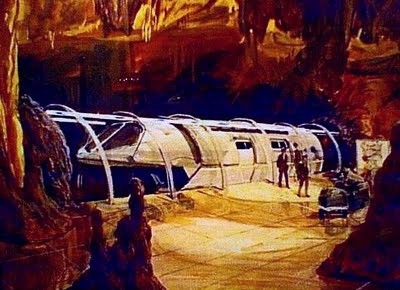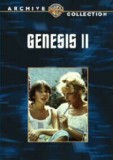| Reviews & Columns |
|
Reviews DVD TV on DVD Blu-ray 4K UHD International DVDs In Theaters Reviews by Studio Video Games Features Collector Series DVDs Easter Egg Database Interviews DVD Talk Radio Feature Articles Columns Anime Talk DVD Savant Horror DVDs The M.O.D. Squad Art House HD Talk Silent DVD
|
DVD Talk Forum |
|
|
| Resources |
|
DVD Price Search Customer Service #'s RCE Info Links |
|
Columns
|
|
|
Genesis II
It's easy to see why Genesis II wasn't picked up: it's simply not very good for a variety of reasons, though even as a footnote in sci-fi television history it's a welcome release. It's a pity the DVD is positively bare bones - a historical audio commentary about its failure could have been more interesting than one about more successful pilots - but the transfer is what counts, and it's decent if unspectacular.
In 1979, deep inside the Carlsbad Caverns in southeastern New Mexico, NASA scientist Dylan Hunt (Alex Cord) decides to test his suspended animation process, "Project Ganymede," on himself. He's sealed away in a pressure chamber in a state of hibernation for what's only supposed to be a few days, but an earthquake buries his lab and, apparently, rescue teams give him up for dead.
One hundred and fifty-four years later, 2133 A.D., an ashen-faced Hunt is found alive and revived by members of PAX, post-apocalyptic decedents of NASA and military personnel who fled underground during the nuclear holocaust of World War III. A woman named Lyra-a (Mariette Hartley) is charged with Hunt's recovery. She's a beautiful mutant (with two hearts, two navels and decked out with an Ursula Andress-style hairpiece) in fact spying on behalf of the Tyranians, who reside in a large modern city on the earth's surface. She convinces Hunt the PAX are militarists systematically conquering and looting the surface world of its treasures and the pair flee to her city, but it's soon clear the Tyranians in fact are totalitarian slave owners (with a name like that, what else could they be?) who merely need Hunt to fix their nuclear generator - as if a NASA scientist specializing in hibernation science could, though Roddenberry seems to think so.
Genesis II is a mess. It does little more than borrow basic concepts from a million other sci-fi stories, tossing them together like an unappetizing salad. The suspended animation bit is straight out of Buck Rogers, for instance, while the Tyranians dress and live like pampered Ancient Greeks and Romans in scenes on par with the average Italian Hercules movie.
Where the original Star Trek series at least attempted to justify its incredible technology scientifically, the science of Genesis II is as wacky as Cat-Women of the Moon. How does Hunt manage to stay alive so long? Why is the power still on? How does PAX keep all their 1970s-style telephones, electric golf carts and other technology in working order with no access to replacement parts? Why do Tyranians have two belly buttons?
The first part of Genesis II is at least okay. The idea of an underground metropolis stuffed with mankind's legacy - millions of books, paintings by the great masters, etc. - is a good one, and the expansive stalactite-filled studio interiors, including one terrific set where the city intersects with a network of high-speed subterranean shuttles is neat-o. Some of the special effects are quite good, especially the show's several fine matte paintings.
Roddenberry's script is also reasonably ambiguous in the first-half in terms of just who the good guys are (other than that too-obvious name), with the audience discovering their motives at the same time as Hunt. But the Tyranian slave culture material is hoary in the extreme and really does play at the unambitious level of a cheap peplum.
Not helping is Genesis II's singularly uncharismatic cast. Alex Cord is not the right match for this material; he's instantly forgettable. Hartley is somewhat better; she had made a memorable appearance in one of Star Trek's last good episodes, "All Our Yesterdays," though here both characters are like cardboard. The show is peculiarly cast: Ted "Lurch" Cassidy plays an oversized Apache Indian, but has almost nothing to do; fat Leon Askin turns up as a slave overseer, the kind of part he stop playing in the mid-1950s, while scrawny Liam Dunn, primarily a comic actor, is cast here in a straight dramatic bit as pathetic old slave. Unsurprisingly, Roddenberry found a role for his actress-wife, Majel Barrett (as a member of the PAX council), while Star Trek's regular DP, Gerald Perry Finnerman, shot this.
Another Trekker, William Ware Theiss, designed the provocatively skimpy but often ludicrous and impractical costumes. PAX personnel wear what look like potato sacks, the Tyranians prance about in toga-type get-ups, while many slaves wear caveman clothes a la The Flintstones. For some reason, nearly everyone in the cast - many of the principals and practically all the extras - wear elaborate but utterly unnatural and unattractive wigs.
Video & Audio
As a Warner Archive title, after the usual promo for its line of titles, the disc goes straight to a "hit play" menu with no other options. The show looks okay; presented in its original full-frame format, this TV-movie is reasonably sharp with okay but unexceptional color. Filmed in standard 35mm. it's about on par with other U.S. shows from the early-1970s shot on film; it doesn't pop off the screen but it's also probably the best it's ever looked, certainly better than the 16mm syndication print I saw this once later in the 1970s. Likewise, the original mono audio is acceptable but nothing to write home about - standard-issue TV movie audio intended for little three-inch TV speakers of the period. There are no alternate audio or subtitle options, and no chapter menu, though there are chapter stops every ten minutes.
Extra Features
None.
Parting Thoughts
Highly derivative and uninspired though in some ways colorful and never dull, Genesis II is a minor blip in the storied career of its writer-producer, but its release to DVD is appreciated anyway. Star Trek and '70s sci-fi fans may find this worth a look. Otherwise, Rent It.
Stuart Galbraith IV's latest audio commentary, part of AnimEigo's forthcoming Tora-san DVD boxed set, is available for pre-order, while his latest book, Japanese Cinema, is in bookstores now.
|
| Popular Reviews |
| Sponsored Links |
|
|
| Sponsored Links |
|
|
| Release List | Reviews | Shop | Newsletter | Forum | DVD Giveaways | Blu-Ray | Advertise |
|
Copyright 2024 DVDTalk.com All Rights Reserved. Legal Info, Privacy Policy, Terms of Use,
Manage Preferences,
Your Privacy Choices | |||||||














